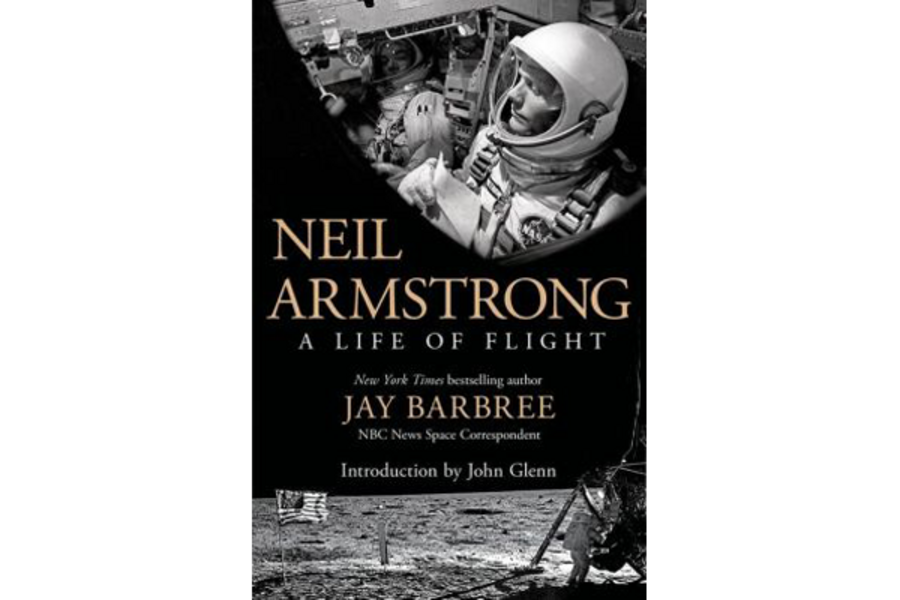'Neil Armstrong' recalls the astronaut, pilot, and man
Loading...
With all that has been written about the late Neil Armstrong, including an award-winning biography by Auburn University historian James Hansen, is there really room for another book?
Sit back, put up your feet, and spend some time with Neil Armstrong: A Life of Flight, by Jay Barbree, NBC’s longtime space correspondent, who has covered the US manned spaceflight program for more than half a century.
To be sure, this is not the definitive, footnote-packed Armstrong biography. Instead, this book has the feel of sitting down with Barbree at a barbeque for an extended conversation. Barbree’s narrative unfolds with a particular eye toward Armstrong’s mastery of the machines he would come to fly, from F9Fs as a Navy carrier pilot during the Korean War and NASA’s X-15 to the ungainly lunar landing training vehicle and Apollo’s Lunar Excursion Module itself.
Indeed, flying is a passion that Barbree and Armstrong shared, although Barbree acknowledges that “as a pilot, I couldn’t carry Neil Armstrong’s lunchbox.”
Drawing on decades of notes, recorded interviews, and e-mails with Armstrong as well as a range of astronauts and key players in launch and mission controls, Barbree begins his account with Armstrong’s service flying F9F jets off the aircraft carrier USS Essex during the Korean War and a mission that nearly cost Armstrong his life.
During a bombing and strafing run in a narrow river valley, an antiaircraft cable the North Koreans had strung across the valley sliced off the outer six to eight feet of Armstrong’s right wing. Armstrong, who had earned a pilot’s license before he had a driver’s license, nearly augered in before he regained control and climbed out of the valley.
The near-crash prompted the relieved Armstrong to remind himself that “20 feet above the ground is no place to be at 350 knots.” Under the care of his wingman, Armstrong nursed the craft back over friendly territory, where he safely ejected.
What seemed to set Armstrong apart was a passion for flight that motivated him to earn an aeronautical engineering degree from Purdue University in West Lafayette, Ind., courtesy of the US Navy, and set as his initial goal a career as a test pilot. And he displayed a coolness in times of apparent crisis, engendered by intensive preparation and a deep understanding of the machines he was flying.
Barbree’s account of Armstrong’s successful battle with an out-of-control Gemini 8 capsule, spinning ever faster because of a malfunctioning thruster, is one of several instances in which he fills in details about the risks encountered during the run-up to the Apollo 11 mission.
His recounting of the Apollo 1 launchpad fire, which killed three astronauts, through the historic mission Armstrong undertook with Buzz Aldrin and Mike Collins, runs at a crisp pace, with occasional flashes of near-poetry.
Following his narrative of the landing, Barbree writes: “They had indeed landed on a dead world. A land that had never known the caress of seas, never felt life stirring in its soil, never felt the smallest leaf drift to its surface.... They were on a world where a thermonuclear fireball would sound no louder than a falling snowflake.”
The prose reflects an appreciation for life and animation born of tragedy that Armstrong and Barbree shared – both their families were confronted with the death of young children. In addition, Barbree survived a heart attack in 1987, one that left him declared clinically dead for several minutes, according to his recounting of the event.
After the shuttle program ended following the second of two tragedies – Challenger and Columbia, which collectively cost the lives of 14 astronauts to lax technical oversight, the result of a creeping willingness to accept dodged bullets as a new normal – both men expressed severe frustration at the unwillingness of successive US administrations and Congresses to fully support with money as well as words a consistent vision for the US human spaceflight program that leads back to the moon and on to explorations of Mars.
Through the years, the two men became close friends, a relationship that is apparent throughout the narrative. Yet, in many ways, this book is as much Barbree’s effort to chronicle the trajectory of the human spaceflight program as it is a remembrance of Armstrong’s contributions during and after his time as an astronaut.
As someone who has covered every US human spaceflight launch, Barbree ends with a not-so subtle sense that another countdown clock is ticking. “Rest in peace, my good man,” he writes to Armstrong who died in 2012. “We’ll be along directly.”
Um, Jay? We may still have some built-in holds scheduled.
Pete Spotts is a Monitor staff writer and science reporter.









